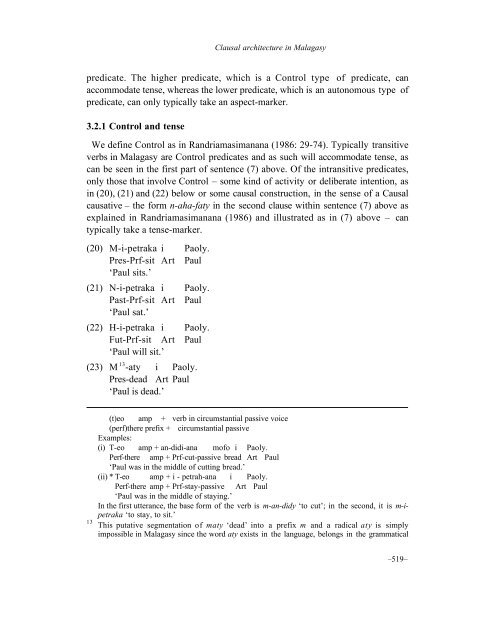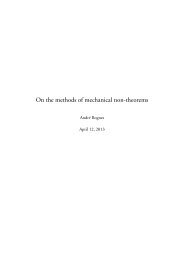Clausal architecture and movement verbs in Malagasy
Clausal architecture and movement verbs in Malagasy
Clausal architecture and movement verbs in Malagasy
You also want an ePaper? Increase the reach of your titles
YUMPU automatically turns print PDFs into web optimized ePapers that Google loves.
<strong>Clausal</strong> <strong>architecture</strong> <strong>in</strong> <strong>Malagasy</strong><br />
predicate. The higher predicate, which is a Control type of predicate, can<br />
accommodate tense, whereas the lower predicate, which is an autonomous type of<br />
predicate, can only typically take an aspect-marker.<br />
3.2.1 Control <strong>and</strong> tense<br />
We def<strong>in</strong>e Control as <strong>in</strong> R<strong>and</strong>riamasimanana (1986: 29-74). Typically transitive<br />
<strong>verbs</strong> <strong>in</strong> <strong>Malagasy</strong> are Control predicates <strong>and</strong> as such will accommodate tense, as<br />
can be seen <strong>in</strong> the first part of sentence (7) above. Of the <strong>in</strong>transitive predicates,<br />
only those that <strong>in</strong>volve Control – some k<strong>in</strong>d of activity or deliberate <strong>in</strong>tention, as<br />
<strong>in</strong> (20), (21) <strong>and</strong> (22) below or some causal construction, <strong>in</strong> the sense of a Causal<br />
causative – the form n-aha-faty <strong>in</strong> the second clause with<strong>in</strong> sentence (7) above as<br />
expla<strong>in</strong>ed <strong>in</strong> R<strong>and</strong>riamasimanana (1986) <strong>and</strong> illustrated as <strong>in</strong> (7) above – can<br />
typically take a tense-marker.<br />
(20) M-i-petraka i Paoly.<br />
Pres-Prf-sit Art Paul<br />
‘Paul sits.’<br />
(21) N-i-petraka i Paoly.<br />
Past-Prf-sit Art Paul<br />
‘Paul sat.’<br />
(22) H-i-petraka i Paoly.<br />
Fut-Prf-sit Art Paul<br />
‘Paul will sit.’<br />
(23) M 13 -aty i Paoly.<br />
Pres-dead Art Paul<br />
‘Paul is dead.’<br />
(t)eo amp + verb <strong>in</strong> circumstantial passive voice<br />
(perf)there prefix + circumstantial passive<br />
Examples:<br />
(i) T-eo amp + an-didi-ana mofo i Paoly.<br />
Perf-there amp + Prf-cut-passive bread Art Paul<br />
‘Paul was <strong>in</strong> the middle of cutt<strong>in</strong>g bread.’<br />
(ii) * T-eo amp + i - petrah-ana i Paoly.<br />
Perf-there amp + Prf-stay-passive Art Paul<br />
‘Paul was <strong>in</strong> the middle of stay<strong>in</strong>g.’<br />
In the first utterance, the base form of the verb is m-an-didy ‘to cut’; <strong>in</strong> the second, it is m-ipetraka<br />
‘to stay, to sit.’<br />
13 This putative segmentation of maty ‘dead’ <strong>in</strong>to a prefix m <strong>and</strong> a radical aty is simply<br />
impossible <strong>in</strong> <strong>Malagasy</strong> s<strong>in</strong>ce the word aty exists <strong>in</strong> the language, belongs <strong>in</strong> the grammatical<br />
–519–

















